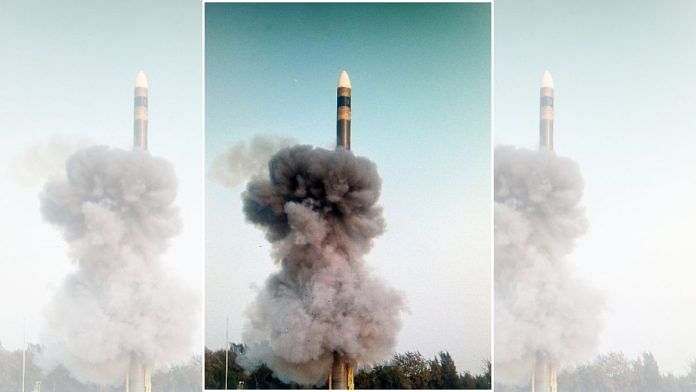India’s recent successful test of MIRVs, Multiple Independently Targeted Re-entry Vehicles, delivered by the AGNI-5 missiles marks the success of its efforts to counter the Ballistic Missile Defense Systems of potential adversaries, China and Pakistan. The implications of MIRVs being included in the existing nuclear arsenal were covered earlier in ThePrint. This article attempts to utilise the limelight of the MIRV success, to highlight a critical issue that requires to be addressed post-haste. It relates to the survivability of India’s Nuclear Command and Control System.
The apex body of the NCCS is the Nuclear Command Authority (NCA). The NCA consists of the prime minister and ministers of defence, home, external affairs and finance. The composition is the same as the Cabinet Committee on Security (CCS) and the National Security Council (NSC).
According to a Press Information Bureau press note from 4 January 2003, the NCA comprised a Political Council, chaired by the prime minister, and an Executive Council, chaired by the national security advisor. Only the PC can authorise the use of nuclear weapons. The EC provides inputs for decision-making and executes the directives given to it by the PC. No official indication has been given of the composition of the EC. It can be expected to have at least the chief of defence staff, chiefs of the armed forces, the commander-in-chief of the Strategic Forces Command and Heads of Departments of Defence, Atomic Energy and DRDO.
Also read: India should declare that AI will not be used to autonomously launch nuclear weapons
Alternative chain of command
The 2003 press note also said that the CCS had reviewed and approved the arrangements for an alternative chain of command for retaliatory nuclear strikes under all eventualities. Understandably, beyond the fact that arrangements exist, nothing is public about the composition of them. One chain for sure would be headed by the prime minister and the head of the other could vary depending on the political party in power.
An alternative chain of command arises from accepting a critical vulnerability that needs to be addressed by nuclear strategy. The vulnerability pertains to two interconnected issues. Both arise from doctrinal prescriptions. One is about the fact that only the PC headed by the PM can authorise the use of nuclear weapons. Therefore, the PC can be a key target for the adversary and if neutralised successfully in the initial stages of a nuclear war, it could paralyse India’s ability to retaliate. This vulnerability is further exacerbated because India is a No First Use nuclear power. Nuclear strategy has to cater to the ability to absorb a nuclear strike and then retaliate.
But creating an alternative chain of command does not solve the problem. Their protection during periods of heightened nuclear alerts and war is also an imperative need. Protection could be provided by moving the alternative PC to secret shelters underground, underwater or in the air. These facilities would also have to be equipped with communication facilities to exercise command and control and have logistic facilities to support their stay.
For good reason, the arrangements that exist to protect the PCs are not publicly known, except in some studies and journalistic reporting. It would be reasonable to assume that underground facilities located in different parts of the country are the main protection arrangements. It is unlikely that there are any protected facilities created underwater. Importantly, there are no indications that an airborne command post has been sanctioned and created. While efforts could be underway to create airborne command posts, it should be done on priority.
Also read: India can maximise its nuclear power with AI but control of weapons must stay with humans
Airborne command is better
Two specially modified Boeing-777 aircraft for use by VVIPs have been available from 2020 onwards. They can counter some types of missile threats and are equipped with Large Aircraft Infrared Countermeasures (LAIRCM) and Self-Protection Suites (SPS). This acquisition cannot be considered the equivalent of a command post during war, where the requirements are much more demanding and include advanced communication systems, command and control facilities that are linked to leaders on the ground and integrated with the broader communication of the military. The airborne command post should also be hardened against Electromagnetic Pulse (EMP) and has to be available 24/7, at extremely short notice.
The case for an airborne command post is strong. First, with the sharpening of satellite-based geospatial monitoring technologies, it is difficult to conceal the existence of underground facilities. Moreover, once located, communications could be jammed. Second, the airborne command post could potentially provide a greater degree of survivability to the PC as it is not fixed in terms of location, has an extensive air space to operate from, and facilitates room for deception through decoys and other measures. However, unlike an underground facility, its endurance is limited to its fuel-carrying capacity. This is mostly offset by the advantages gained in terms of protection. Preferably, one command chain could operate from an underground facility and the other could be airborne.
Survivability of the nuclear command authority is paramount and the airborne command post provides additional redundancy which strengthens survivability and deterrence. Moreover, as India modernises and upgrades its nuclear retaliation capabilities through MIRVs and other land and sea-based delivery platforms, it should be accompanied by complementary efforts to strengthen the survivability of the critical command and control elements. Without it, the executive end of the arsenal will keep waiting for orders that may never reach them.
Lt Gen (Dr) Prakash Menon (retd) is Director, Strategic Studies Programme, Takshashila Institution; former military adviser, National Security Council Secretariat. He tweets @prakashmenon51. Views are personal.
(Edited by Theres Sudeep)



